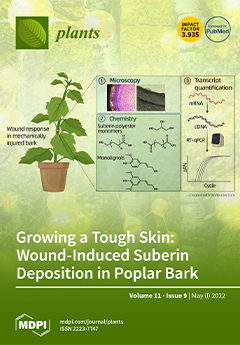Soybean seeds are rich in secondary metabolites which are beneficial for human health, including tocopherols. Tocopherols play an important role in human and animal nutrition thanks to their antioxidant activity. In this study, the ‘Forrest’ by ‘Williams 82’ (F×W82) recombinant inbred line (RIL) population (
n = 306) was used to map quantitative trait loci (QTL) for seed α-tocopherol, β-tocopherol, δ -tocopherol, γ-tocopherol, and total tocopherol contents in Carbondale, IL over two years. Also, the identification of the candidate genes involved in soybean tocopherols biosynthetic pathway was performed. A total of 32 QTL controlling various seed tocopherol contents have been identified and mapped on Chrs. 1, 2, 5, 6, 7, 8, 9, 10, 12, 13, 16, 17, and 20. One major and novel QTL was identified on Chr. 6 with an R
2 of 27.8, 9.9, and 6.9 for δ-tocopherol, α-tocopherol, and total tocopherol content, respectively. Reverse BLAST analysis of the genes that were identified in
Arabidopsis allowed the identification of 37 genes involved in soybean tocopherol pathway, among which 11 were located close to the identified QTLs. The tocopherol cyclase gene (
TC)
Glyma.06G084100 is located close to the QTLs controlling δ-tocopherol (R
2 = 27.8), α-tocopherol (R
2 = 9.96), and total-tocopherol (R
2 = 6.95). The geranylgeranyl diphosphate reductase (
GGDR)
Glyma.05G026200 gene is located close to a QTL controlling total tocopherol content in soybean (R
2 = 4.42). The two methylphytylbenzoquinol methyltransferase (
MPBQ-MT) candidate genes
Glyma.02G002000 and
Glyma.02G143700 are located close to a QTL controlling δ-tocopherol content (R
2 = 3.57). The two γ-tocopherol methyltransferase (
γ-TMT) genes,
Glyma.12G014200 and
Glyma.12G014300, are located close to QTLs controlling (γ+ß) tocopherol content (R
2 = 8.86) and total tocopherol (R
2 = 5.94). The identified tocopherol seed QTLs and candidate genes will be beneficial in breeding programs to develop soybean cultivars with high tocopherol contents.
Full article






